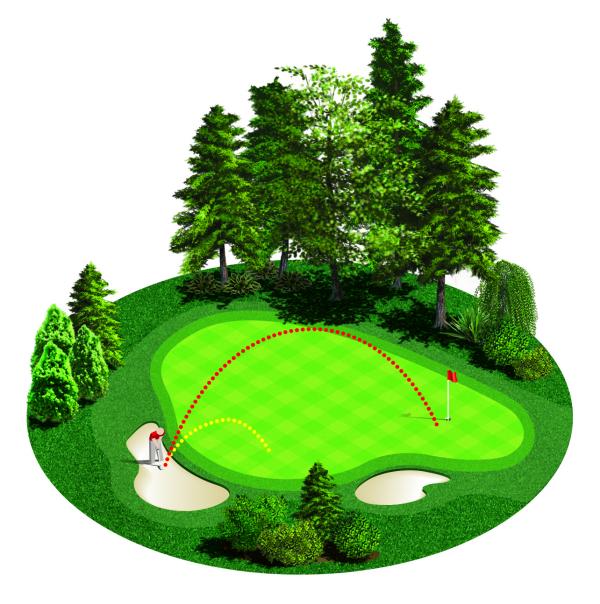After finishing tied for ninth at the U.S. Open and tied for fourth at the British Open, Jason Day broke through with a victory at the RBC Canadian Open. This was Day’s fourth win on the PGA TOUR and his second win this season.
Day won with a one-two combination of great putting and great driving. Day beat the field by an average of 3.5 strokes per round in his victory. Putting contributed 51 percent of his gain (1.8 strokes per round, rank 5) and driving contributed another 31 percent (1.3 strokes per round, rank 1).
On Hole 17 in the final round, Day hit his drive 386 yards compared to the field average of 314 yards and gained nearly 0.3 strokes on the field. Day said, “I’ve never hit a drive that long … It was just one of those freak kind of drives where it just popped off really nice.” For the tournament, Day’s tee shots on par-4 and par-5 holes averaged 321 yards, a massive 22 yards longer than the field average of 299 yards. He also hit 55 percent fairways and first cuts, just under the field average of 57 percent. After the round Day said, “I was timing my drives really well this week. I was hitting it very straight and very long.”
It’s unusual for a player to win while losing strokes to the field with approach shots, but Day lost an average of 0.2 strokes per round versus the field with his approach shots (and was ranked 64 in that strokes gained category). Here’s a round-by-round strokes gained breakdown of Day’s play at the RBC Canadian Open:
| Strokes gained per round (ranks in parentheses) | Rank | |||||
| Jason Day | Total | Drive | Appr | Short | Putt | out of |
| 2015 Season | 1.6 (10) | 0.5 (14) | 0.2 (79) | 0.3 (33) | 0.5 (17) | 213 |
| RBC Canadian Open | 3.5 (1) | 1.3 (1) | -0.2 (64) | 0.5 (23) | 1.8 (5) | 78 |
| Round 1 | 3.1 (20) | 0.5 (48) | -1.3 (124) | 3.1 (1) | 0.8 (44) | 156 |
| Round 2 | 5.2 (9) | 2.0 (3) | 0.9 (50) | -0.8 (117) | 3.1 (6) | 154 |
| Round 3 | 2.3 (21) | 1.6 (3) | 0.1 (41) | -0.1 (50) | 0.6 (35) | 91 |
| Round 4 | 3.2 (8) | 1.2 (7) | -0.4 (48) | -0.1 (48) | 2.5 (7) | 78 |
Bubba Watson’s second-place finish was powered by his approach shots and driving. Approach shots contributed 55 percent of his gain (1.8 strokes per round, rank 1) and driving contributed another 39 percent (1.3 strokes per round, rank 2). Here’s a round-by-round strokes gained breakdown of Watson’s play at the RBC Canadian Open:
| Strokes gained per round (ranks in parentheses) | Rank | |||||
| Bubba Watson | Total | Drive | Appr | Short | Putt | out of |
| 2015 Season | 2.4 (3) | 1.3 (1) | 0.8 (5) | -0.1 (168) | 0.4 (28) | 213 |
| RBC Canadian Open | 3.2 (2) | 1.3 (2) | 1.8 (1) | -0.2 (51) | 0.3 (38) | 78 |
| Round 1 | 3.1 (17) | 1.4 (11) | 2.8 (9) | -0.6 (108) | -0.5 (97) | 156 |
| Round 2 | 4.2 (16) | 0.6 (53) | 3.2 (9) | -1.3 (131) | 1.7 (25) | 154 |
| Round 3 | 3.3 (13) | 1.3 (8) | 1.8 (16) | 0.7 (29) | -0.5 (55) | 91 |
| Round 4 | 2.2 (20) | 1.8 (1) | -0.8 (58) | 0.6 (20) | 0.6 (29) | 78 |
David Hearn came up two shots short in his bid to become the first Canadian in 61 years to win his national open. Hearn finished second in strokes gained putting, gaining an average of 2.2 strokes per round on the field. After gaining 3.6, 3.0, and 2.8 strokes with his putter in the first three rounds, he lost 0.7 strokes with his putter in the final round. Hearn said, “I’ve been putting the ball great all week … Right toward the middle of the round there I did hit a lot of really, really good putts that didn’t quite go in.” Here’s a round-by-round strokes gained breakdown of Hearn’s play at the RBC Canadian Open:
| Strokes gained per round (ranks in parentheses) | Rank | |||||
| David Hearn | Total | Drive | Appr | Short | Putt | out of |
| 2015 Season | 0.4 (79) | -0.2 (151) | 0.2 (78) | 0.0 (118) | 0.4 (34) | 213 |
| RBC Canadian Open | 3.0 (3) | -0.1 (51) | 0.3 (48) | 0.7 (19) | 2.2 (2) | 78 |
| Round 1 | 2.1 (49) | -0.3 (108) | -0.4 (100) | -0.7 (109) | 3.6 (3) | 156 |
| Round 2 | 7.2 (2) | 0.3 (71) | 2.0 (22) | 1.9 (12) | 3.0 (7) | 154 |
| Round 3 | 3.3 (10) | -0.5 (64) | -0.1 (47) | 1.1 (18) | 2.8 (4) | 91 |
| Round 4 | -0.8 (46) | -0.1 (46) | -0.4 (50) | 0.4 (29) | -0.7 (50) | 78 |
The top finishers at the RBC Canadian Open gained 41 percent of the strokes on the field with their putting and just 13 percent with their approach shots. Here’s a strokes gained breakdown of the top ten finishers:
| Strokes gained per round (ranks in parentheses) | |||||
| Golfer | Total | Drive | Appr | Short | Putt |
| Jason Day | 3.5 (1) | 1.3 (1) | -0.2 (64) | 0.5 (23) | 1.8 (5) |
| Bubba Watson | 3.2 (2) | 1.3 (2) | 1.8 (1) | -0.2 (51) | 0.3 (38) |
| David Hearn | 3.0 (3) | -0.1 (51) | 0.3 (48) | 0.7 (19) | 2.2 (2) |
| Jim Furyk | 2.7 (4) | 0.2 (38) | 0.2 (50) | 1.2 (2) | 1.1 (11) |
| Stewart Cink | 2.5 (T5) | 0.8 (14) | 0.6 (33) | 0.4 (28) | 0.7 (20) |
| Tom Hoge | 2.5 (T5) | 0.0 (48) | 0.9 (18) | 0.4 (27) | 1.2 (9) |
| Adam Hadwin | 2.2 (T7) | 0.5 (26) | -0.2 (65) | 0.6 (22) | 1.3 (8) |
| Matt Kuchar | 2.2 (T7) | 1.0 (9) | 0.4 (40) | 0.9 (8) | -0.1 (58) |
| Austin Cook | 2.2 (T7) | 0.5 (27) | 0.3 (45) | 0.4 (30) | 1.0 (13) |
| Charley Hoffman | 2.2 (T7) | 1.2 (3) | -0.6 (73) | 0.2 (42) | 1.4 (7) |
| Top 10 average | 2.6 | 0.7 | 0.3 | 0.5 | 1.1 |
| Fraction of total | 100% | 26% | 13% | 19% | 41% |
Here’s a strokes gained breakdown of the final round for the top ten finishers at the RBC Canadian Open:
| Strokes gained in the final round (ranks in parentheses) | |||||
| Player | Total | Drive | Appr | Short | Putt |
| Jason Day | 3.2 (8) | 1.2 (7) | -0.4 (48) | -0.1 (48) | 2.5 (7) |
| Bubba Watson | 2.2 (20) | 1.8 (1) | -0.8 (58) | 0.6 (20) | 0.6 (29) |
| David Hearn | -0.8 (46) | -0.1 (46) | -0.4 (50) | 0.4 (29) | -0.7 (50) |
| Jim Furyk | 2.2 (17) | 0.4 (33) | 1.1 (20) | 0.4 (31) | 0.4 (32) |
| Stewart Cink | 5.2 (3) | 0.8 (19) | 1.9 (8) | 0.0 (46) | 2.6 (6) |
| Tom Hoge | 5.2 (2) | 0.2 (35) | 2.0 (6) | 0.2 (36) | 2.8 (5) |
| Adam Hadwin | 3.2 (13) | 0.9 (17) | 0.1 (37) | 1.2 (6) | 1.0 (25) |
| Matt Kuchar | 2.2 (15) | 1.0 (15) | 4.4 (2) | -1.2 (68) | -1.9 (68) |
| Austin Cook | 2.2 (25) | -0.1 (50) | -0.1 (40) | 0.7 (19) | 1.8 (11) |
| Charley Hoffman | 1.2 (28) | 0.1 (42) | -0.6 (55) | 0.3 (34) | 1.5 (14) |
This post appeared originally on pgatour.com here
A very brief explanation of strokes gained: Strokes gained is a measure of the quality of a golf shot. A shot with positive strokes gained indicates a better-than-average shot for a PGA TOUR pro. For example, suppose on a difficult par-4 that the PGA TOUR average score is 4.2. An average drive for a PGA TOUR player would reduce the average strokes to hole out by one, from 4.2 to 3.2. If a player hit a long drive into the fairway where the PGA TOUR average strokes to hole out is 2.9, then the shot gained 0.3 strokes compared to the PGA TOUR average. If a player hit a short drive into the rough where the PGA TOUR average strokes to hole out is 3.4, then the shot lost 0.2 strokes compared to the PGA TOUR average. Strokes gained from all shots are accumulated and grouped into convenient categories to measure the performance of players in a round, tournament, or season. For example, the gain from all tee shots on par-4 and par-5 holes is strokes gained driving measure. The gain from all shots starting outside 100 yards from the hole, excluding tee shots on par-4 and par-5 holes, is strokes gained from approach shots.


